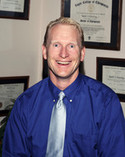FOCAL -vs- DIFFUSE
LATERAL VIEW OF A DISC HERNIATION
Spinal Discs are the flexible "bushings" between your vertebrae. Their to main jobs are to create space for the spinal nerves as they exit the spinal cord through bony windows called Intervertebral Foramen (IVF), and to act as shock absorbers. The discs are made up of two distinct parts
- ANNULUS FIBROSUS: The Annulus is the outer part of the disc. It is made up of ligamentous rings (like the rings on a tree). The center-most portion of the Annulus Fibrosis contains the.........
- NUCLEUS PULPOSUS: The Nucleus is the jelly center that is contained within the Annulus. Fluid cannot be compressed, thus these jelly centers are tremendous shock absorbers.
As you bear weight, the pressure pushes the Nucleus toward the outside of the disc in 360 degrees. When you bend forward (which we all do far more often than bending backwards), the Nucleus is pushed more towards the back of the disc. The Annular fibers are typically tough enough to contain the disc during normal activities, including work. But when stressed by too much discal pressure, these layers of ligaments can begin to fail from the inside out. As the innermost layers of the Annulus start to tear, the Nuclear Jelly begins to "bulge" towards the outsides (right or left or both) of the rear of the disc. The greater the tearing, the greater the bulge.
The injuries that cause Spinal Discs to bulge / herniate can be due to either acute trauma or repetitive physical stresses. These mechanical stresses overcome the injured or weakened Annular Ligaments and allow the Nuclear Jelly to bulge outward. If the bulge (often referred to as a DISC HERNIATION) protrudes in a small area (less than 25% of the disc's circumference), we refer to it as a Focal Disc Bulge. But all too often, the Spinal Disc may bulge or "herniate" over a large area (up to 50% of the disc's circumference). This is called a Diffuse Disc Bulge aka a Broad Based Disc Bulge.
As you can imagine, the differences in the two are not insignificant. Focal Disc Bulges are more localized, causing pain that tends to be focused to only one area. This is because there are fewer nerves involved. Be aware, however, that a Focal Disc Herniation can and often does cause SCIATICA. Because Diffuse Disc Bulges take up more space, they tend to cause a wider array of symptoms. The pain is often on both sides, and because the herniation often involves pressure on the cord itself, the pain and other symptoms can give the appearance of coming from multiple spinal levels of nerves.
Although it is not critical, it helps to know what kind of DISC HERNIATION you are dealing with. This is because despite the fact that they are treated in essentially the same manner, the recovery time may be longer for a Broad Based or Diffuse Disc Bulge than it is for a Focal Disc Bulge. For a Free consultation with Dr Schierling, please call us at (417) 934-6337 to schedule an appointment. I will take a few minutes to talk to you, look over your MRI, and briefly examine you. Please be aware that only about 50% of the people I consult with are allowed to become Spinal Decompression patients. This is because NOT EVERYONE IS A GOOD CANDIDATE for Spinal Decompression Therapy. If I do not think that Spinal Decompression will help you, I will tell you up front.




 RSS Feed
RSS Feed
